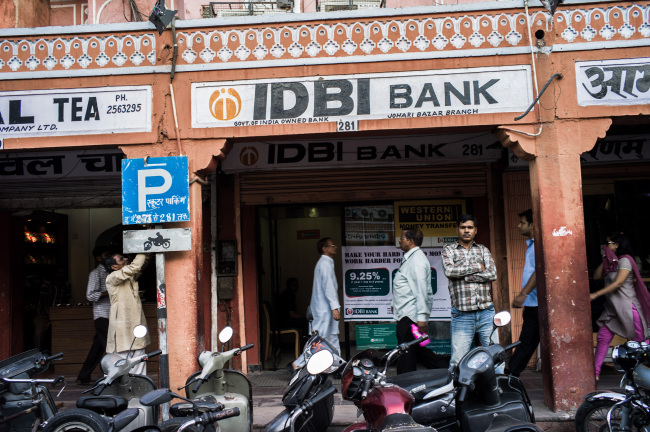Are toilets and bank accounts connected? In India, yes
By Korea HeraldPublished : Oct. 1, 2014 - 21:07
Prime Minister Narendra Modi’s plan to develop India includes creating toilet access for all 1.2 billion people and opening a bank account for every adult who doesn’t already have one. India’s state-owned lenders are being called on to do both, threatening to erode profits and add expenditures at firms saddled with nonperforming loans.
Modi has asked banks to open branches within 5 kilometers of all of India’s 664,000 villages in order to reach 75 million households that have no access to formal financial services. After he announced on Aug. 15 a mission to build toilets in public schools, the Finance Ministry sent a memo to state-owned lenders urging them to pay for construction, according to a senior banking executive who saw it and didn’t want to be identified as the communication wasn’t public.
Banks have committed 740 million rupees ($12 million) to the toilet-building efforts, using funds for tax-advantaged corporate social responsibility projects, according to G.S. Sandhu, banking secretary at India’s Finance Ministry. They also registered 50 million new account holders and collected 35 billion rupees in deposits using temporary kiosks in villages and enlisting rural shop owners as representatives, he said.
Modi has asked banks to open branches within 5 kilometers of all of India’s 664,000 villages in order to reach 75 million households that have no access to formal financial services. After he announced on Aug. 15 a mission to build toilets in public schools, the Finance Ministry sent a memo to state-owned lenders urging them to pay for construction, according to a senior banking executive who saw it and didn’t want to be identified as the communication wasn’t public.
Banks have committed 740 million rupees ($12 million) to the toilet-building efforts, using funds for tax-advantaged corporate social responsibility projects, according to G.S. Sandhu, banking secretary at India’s Finance Ministry. They also registered 50 million new account holders and collected 35 billion rupees in deposits using temporary kiosks in villages and enlisting rural shop owners as representatives, he said.

“The announced financial-inclusion mission will be a drag on profitability of the government-controlled banks in the short-to-medium term,” Vibha Batra, the New Delhi-based head of financial-industry ratings at ICRA Ltd., the local unit of Moody’s Investors Service, said in an interview. “The lenders’ ability to recover the costs from these marginal customers through fee-based initiatives and low-cost savings deposits remains to be proven.”
The cost of delivering services to marginal customers, defined as those lacking access to the banking industry, is as much as 10 times to 12 times the revenue potential, according to a 2011 Boston Consulting Group report. Profitability as measured by return on assets at India’s 26 state-run lenders may fall further from the lowest level in at least 12 years as they bring unbanked households into the system, according to Moody’s, which didn’t provide an estimate.
Raghuram Rajan, governor of the Reserve Bank of India, called attention to the matter in a Sept. 15 speech in Mumbai.
“The public-sector banks are there to undertake social actions when necessary, but those mandates should be backed by financial gains,” he said. “After all, public-sector banks also have private shareholders and are not any longer an extension of the government. They should be seen as independent entities.”
IDBI Bank Ltd., based in Mumbai, and Indian Overseas Bank in Chennai announced plans to build boys’ and girls’ facilities in 359 schools near their branches. IDBI said it would spend 90 million rupees, while IOB didn’t disclose its budget.
D.S. Malik, a Finance Ministry spokesman, declined to comment on the memo asking for banks’ participation in the toilet-construction program, which is designed to combat a sanitation problem that costs India an estimated 600,000 lives annually from diarrhea and exposes a third of the women to the risk of rape or sexual assault.
Nonperforming loans at Indian banks were 4 percent of the total as of March 31, down from 4.2 percent in September 2013, the highest level since 2006. At IDBI, they increased 1.3 percentage points to 5.6 percent of the total in the 12 months ended June 30 compared with the same period a year earlier. Return on equity, a gauge of profitability, fell to a third of what it was the previous year.
Return on equity at all Indian lenders dropped to 9.6 percent as of March 31, the lowest since at least 2002, the Reserve Bank of India said in June. (Bloomberg)
-
Articles by Korea Herald












![[Today’s K-pop] BTS pop-up event to come to Seoul](http://res.heraldm.com/phpwas/restmb_idxmake.php?idx=644&simg=/content/image/2024/04/17/20240417050734_0.jpg&u=)





![[KH Explains] Hyundai's full hybrid edge to pay off amid slow transition to pure EVs](http://res.heraldm.com/phpwas/restmb_idxmake.php?idx=652&simg=/content/image/2024/04/18/20240418050645_0.jpg&u=20240419100350)

